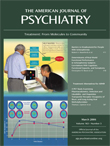Impairment in the Specificity of Emotion Processing in Schizophrenia
Abstract
OBJECTIVE: Deficits in emotion processing are a hallmark of schizophrenia, with consequences for social functioning and subjective well-being. However, their specificity and characteristics have not been ascertained psychometrically. The authors’ purpose was to examine a differential deficit for processing emotional facets of the face compared to judgment of nonemotional features (age) and facial memory. The authors also sought to establish whether the deficit affects sensitivity or specificity of performance. METHOD: Participants were 20 patients with schizophrenia and 20 healthy subjects matched for age, gender, and parental education. The authors examined emotional discrimination abilities compared to age discrimination and recognition memory for faces with standardized faces displaying the universal emotions of happiness, sadness, anger, and fear. Percent correct in each condition and for each emotion were assessed as well as sensitivity (correct identification of a target emotion) and specificity (correct rejection of a nontarget emotion) for emotion recognition. RESULTS: Patients with schizophrenia were differentially impaired in the discrimination of emotional aspects of facial expressions compared to nonemotional aspects and memory. Within the emotional task, patients showed differential impairment in specificity and insensitivity to the emotion displayed. CONCLUSIONS: When identical stimuli were used across tasks, differential impairment was seen in patients with schizophrenia for processing emotional faces, although the nonemotional task proved harder for both groups. Impairment in the specificity of emotion identification may lead to misunderstanding of social communication and may underlie difficulties in social adjustment experienced by people with schizophrenia. Emotion discrimination tests could augment the neurobehavioral evaluation of patients.



